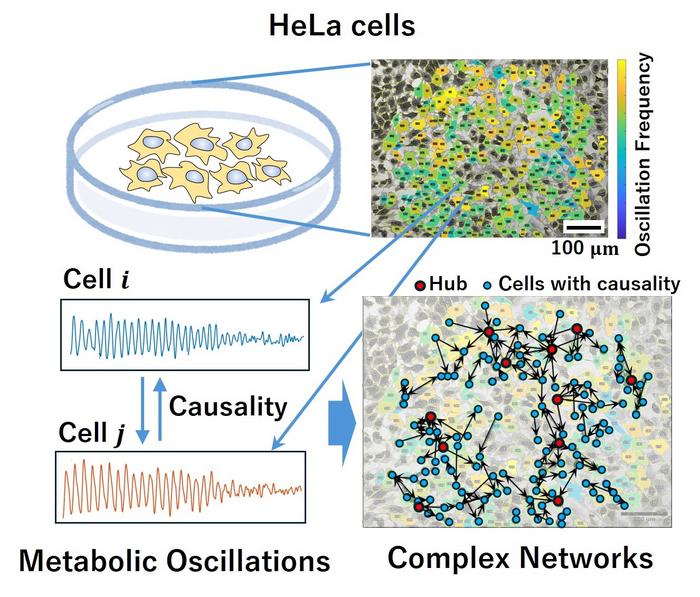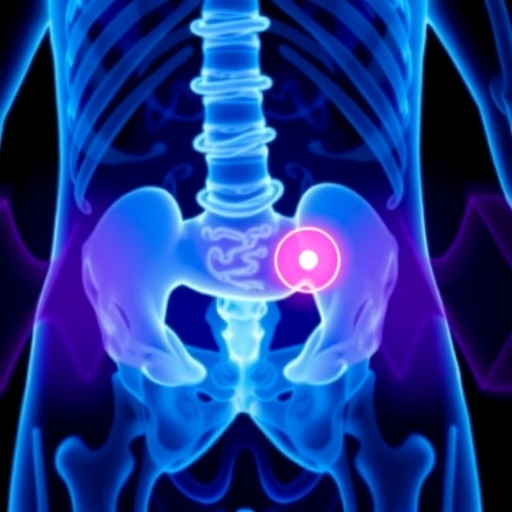
In a groundbreaking study published in Scientific Reports, a team of researchers from YOKOHAMA National University has unveiled a novel phenomenon in cellular interactions, particularly focusing on HeLa cervical cancer cells. Their exploration indicates that these cells maintain a complex, cooperative network of metabolic interactions. This intricate web of connections has profound implications for our understanding of tumor biology and the underlying mechanisms of cancer progression. Understanding these metabolic ties could mark a significant leap toward innovative therapeutic strategies aimed at combating cancer.
HeLa cells, cultivated since 1951, represent the world’s first immortalized human cell line, enabling extensive research in various medical fields. These cancer cells exhibit unique metabolic patterns, characterized by rhythmic oscillations in metabolite levels, particularly within the glycolytic pathway. Such fluctuations, resembling a biological heartbeat, suggest that HeLa cells interact more intricately than previously recognized. This revelation adds a layer of complexity to our understanding of cancer cell behavior, challenging the notion that these interactions might be weak and insignificant.
What sets this research apart is its use of advanced statistical methodologies to reconstruct hidden causal networks among these cells. By leveraging a technique known as Convergent Cross Mapping, the researchers were able to probe deeper into the dynamics of cellular interactions, revealing the hidden structures that facilitate these metabolic oscillations. This method relies on the reconstruction of phase-space from time series data, allowing researchers to delve into the weak interactions that our traditional analytical tools might overlook. Such a detailed approach reveals that the collective behavior of cancer cells can significantly influence their metabolism and, ultimately, their proliferation and survival in diverse microenvironments.
The concept of global cooperative phenomena emerges from this research, describing how individual elements within a network can engage in complex interactions, leading to the emergence of new, global behaviors. The authors delineate how certain central cells act as hubs in this network, instigating or amplifying interactions. This contrasts sharply with the previous assumption of a random or minimally interactive network among HeLa cells. Instead, the research posits that these cells can form a metabolically interlinked functional network that underpins their survivability and adaptability in the highly competitive cancer microenvironment.
Moreover, these metabolic oscillations provide insights into cancer aggressiveness and plasticity. By characterizing the glycolytic oscillation patterns, the research team surmises that the exchange of metabolites, such as lactate, plays a pivotal role in establishing and maintaining these cooperative networks. This exchange could contribute to a symbiotic relationship among cancer cells, enhancing their collective energy efficiency and adaptability, ultimately leading to a more malignant phenotype. Understanding the nuances of these interactions is not merely an academic pursuit; it could translate into therapeutic strategies that effectively target these metabolic pathways, disrupting the survival mechanisms of cancer cells.
While the study focuses on HeLa cells, the implications of its findings extend far beyond. The framework developed could be highly beneficial for examining metabolic phenomena in other cell types, including those critical for maintaining body homeostasis, such as pancreatic beta cells responsible for insulin production. The potential applications of this research suggest that uncovering these hidden networks may also elucidate new dimensions in metabolic regulation across normal and pathological states.
In their analysis, the research team underscores the importance of gaining insights into these ‘cancer-cell hubs’ that interconnect through metabolic networks. The identification of these hubs holds promise for new cancer therapies aimed at disrupting energy symbiosis, thus targeting the metabolic underpinnings that foster tumor growth and metastasis. The authors intend to further explore these networks to unveil additional therapeutic windows that could inhibit or reshape cancer metabolism.
Historically, the investigation of metabolic oscillations in cancer cells has remained largely unexplored. This study marks a pivotal breakthrough by confirming that even weak intercellular interactions can yield significant cooperative phenomena, which fundamentally alter our understanding of how cancer cells operate on a macro level. As noted by Takashi Amemiya, these findings challenge long-standing beliefs regarding cellular metabolism and its regulation in the context of cancer.
The implications of this work resonate throughout the scientific community as new pathways for cancer therapy are opened. By identifying how cellular networks cooperate and share resources through metabolic exchanges, researchers can pinpoint novel targets for intervention. The potential to manipulate these networks could provide crucial insights into combatting the adaptation mechanisms that make cancer so resilient and challenging to treat comprehensively.
As researchers continue to delve into the cellular intricacies explored in this study, it becomes increasingly evident that our understanding of cancer is incomplete without considering the collaborative behaviors among cells. The study paves the way for multidisciplinary approaches to cancer research, integrating insights from cellular biology, biochemistry, and mathematics to further decode the complexities of cancer metabolism.
In conclusion, the research spearheaded by the YOKOHAMA National University team signifies a dramatic shift in the landscape of cancer research. The discovery of a hidden causal interaction network among HeLa cells not only enriches our understanding of cellular behavior but also sets the stage for innovative therapeutic strategies focusing on disrupting these complex networks. As the scientific community absorbs the implications of this work, future research will undoubtedly delve deeper into these cooperative phenomena, unearthing more essential truths about cancer biology and potential interventions.
Subject of Research: Causal interaction of metabolic oscillations in cervical cancer cells
Article Title: Causal interaction of metabolic oscillations in monolayers of HeLa cervical cancer cells: emergence of complex networks
News Publication Date: 3-Mar-2025
Web References: Scientific Reports
References: 10.1038/s41598-025-91711-8
Image Credits: Credit: YOKOHAMA National University
Keywords: HeLa cells, cancer metabolism, metabolic oscillations, glycolytic pathway, cancer therapy, cooperative phenomena, statistical methods, Convergent Cross Mapping, cancer microenvironment, energy symbiosis, tumor biology, cellular interactions.
Tags: advanced statistical methodologies in researchcervical cancer cell interactionsConvergent Cross Mapping techniquecooperative cellular behavior in cancergroundbreaking cancer research findingsHeLa cell line historyHeLa cell metabolic networkimplications of cancer cell interactionsinnovative cancer therapiesmetabolic oscillations in cancer cellstumor biology advancementsunderstanding cancer progression mechanisms





